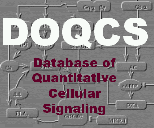
|
Enter a Search String | | Special character and space not allowed in the query term.
Search string should be at least 2 characters long. |
Molecule Parameter List for CaM-PSD | The statistics table lists the distribution of a molecule acting either as a substrate, product, enzyme or as a molecule within the network.
The text color of a molecule is highlighted by  color. color. | | Statistics |
Accession and Pathway Details | |
| Accession Name | Accession No. | Accession Type | Pathway Link | AMPAR_CaMKII_
weak_coupling | 65 | Network |
Shared_Object_AMPAR_CaMKII_weak_coupling, CaMKII, CaM,
PP1, PP2B, PP1_PSD,
AMPAR, PKA, AC,
AMPAR_memb, PP1_CaMKII_PSD, CaMKII_PSD | | This is a model of weak coupling between the AMPAR traffikcing bistability, and the CaMKII autophosphorylation bistability. In this model, there are three stable states: Both off, AMPAR on, or both on. The fourth possible state: CaMKII on but AMPAR off, is not truly stable, since over the course of hours the AMPAR also turns on. |
CaM-PSD acting as a Molecule in AMPAR_CaMKII_weak_coupling Network
| Name | Accession Name | Pathway Name | Initial Conc.
(uM) | Volume
(fL) | Buffered | | CaM-PSD | AMPAR_CaMKII_
weak_coupling
Accession No. : 65 | CaM
Pathway No. : 283 | 26.3333 | 0.01 | No | | There is a LOT of this in the cell: upto 1% of total protein mass. (Alberts et al) Say 25 uM. Meyer et al Science 256 1199-1202 1992 refer to studies saying it is comparable to CaMK levels. |
CaM-PSD acting as a Product of an Enzyme in AMPAR_CaMKII_weak_coupling Network
CaM-PSD acting as a Substrate in a reaction in AMPAR_CaMKII_weak_coupling Network
| Kd is calculated only for second order reactions, like nA+nB <->nC or nA<->nC+nD, where n is number and A,B,C,D are molecules, where as for first order reactions Keq is calculated.
Kd for higher order reaction are not consider. |
| | Name | Accession Name | Pathway Name | Kf | Kb | Kd | tau | Reagents | | 1 | CaM-TR2-bind-Ca-
PSD | AMPAR_CaMKII_
weak_coupling
Accession No. : 65 | CaM
Pathway No. : 283 | 72
(uM^-2 s^-1) | 72
(s^-1) | Kd(af) = 1(uM) | - | Substrate
Ca-PSD
Ca-PSD
CaM-PSD
Product
CaM-TR2-Ca2-PSD
| | | Lets use the fast rate consts here. Since the rates are so different, I am not sure whether the order is relevant. These correspond to the TR2C fragment. We use the Martin et al rates here, plus the Drabicowski binding consts. All are scaled by 3X to cell temp. kf = 2e-10 kb = 72 Stemmer & Klee: K1=.9, K2=1.1. Assume 1.0uM for both. kb/kf=3.6e11. If kb=72, kf = 2e-10 (Exactly the same !).... | | 2 |
neurogranin-bind
-CaM_
PSD | AMPAR_CaMKII_
weak_coupling
Accession No. : 65 | CaM
Pathway No. : 283 | 0.3
(uM^-1 s^-1) | 1
(s^-1) | Kd(bf) = 3.3333(uM) | - | Substrate
CaM-PSD
neurogranin_PSD
Product
neurogranin-CaM_
PSD
| | | Surprisingly, no direct info on rates from neurogranin at this time. These rates are based on GAP-43 binding studies. As GAP-43 and neurogranin share near identity in the CaM/PKC binding regions, and also similarity in phosph and dephosph rates, I am borrowing GAP-43 kinetic info. See Alexander et al JBC 262:13 6108-6113 1987 |
| Database compilation and code copyright (C) 2022, Upinder S. Bhalla and NCBS/TIFR
This Copyright is applied to ensure that the contents of this database remain freely available. Please see FAQ for details. |
|
